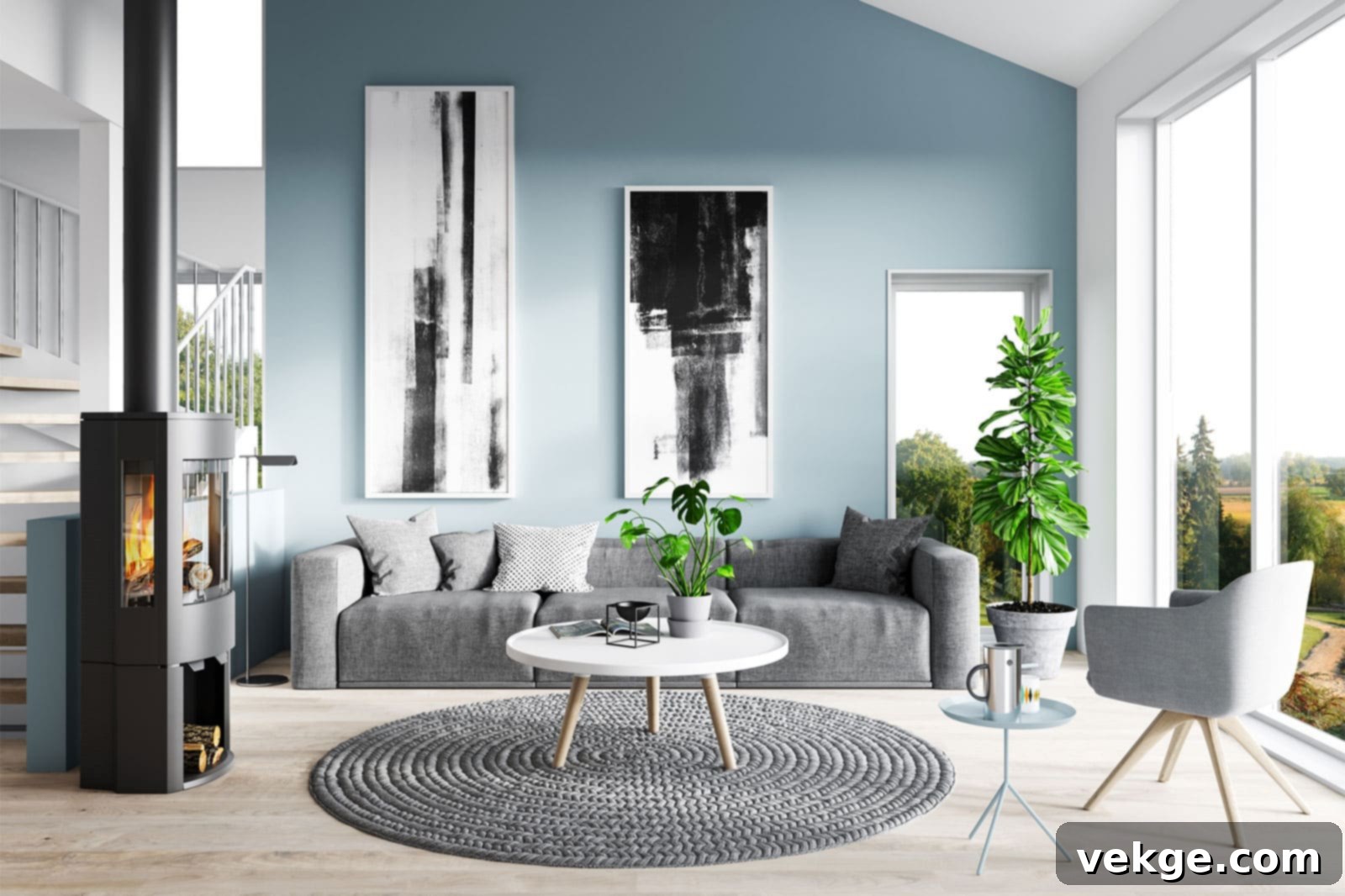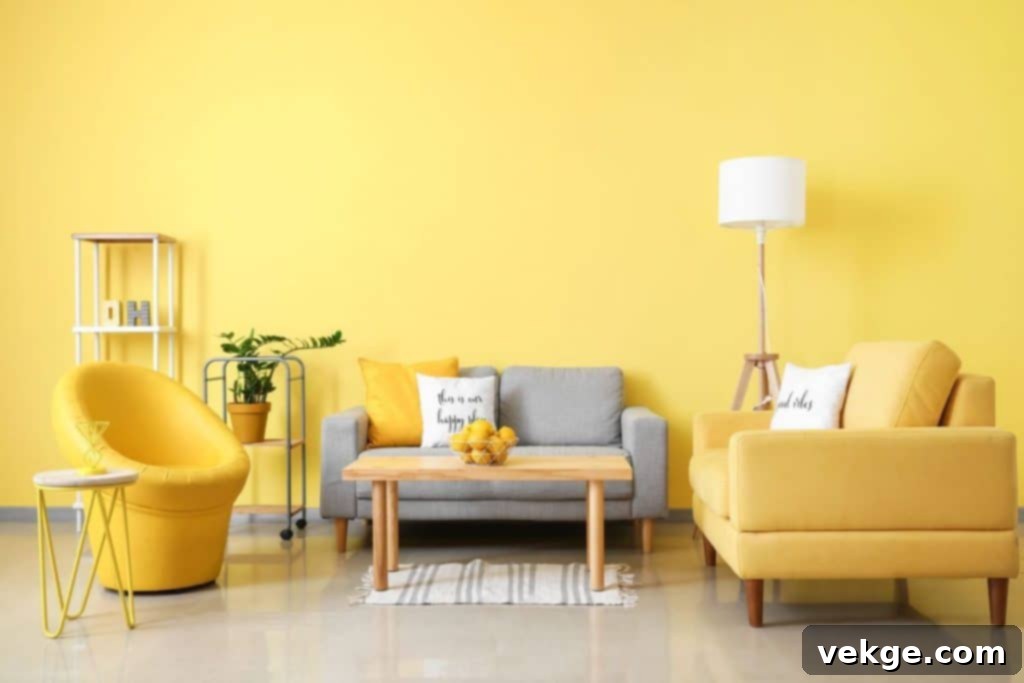Unlocking Serenity: Your Ultimate Guide to Calming Colors for a Peaceful Home
Colors possess an extraordinary power to influence our emotions, mood, and overall sense of well-being. The interplay of vision and light is fundamental to how we perceive these hues, and in turn, how they make us feel. For instance, a dimly lit room can cast a dull pallor, directly impacting our spirits and perception of the colors within. Conversely, thoughtful color choices, especially when paired with adequate lighting, can transform a mere space into a haven of tranquility.
When it comes to decorating our homes, selecting the right color palette is paramount, particularly when the goal is to cultivate a calming environment. We all aspire to create visually appealing spaces that not only look good but also foster relaxation and peace in our daily lives. This article serves as your comprehensive guide, simplifying the quest for the perfect calming colors to infuse your home with an unparalleled sense of serenity and comfort.
Top Color Choices to Create a Calming Room Setup
Achieving a truly calming and relaxed atmosphere in any room is a nuanced process, influenced by a multitude of factors. From the existing architectural features and furniture to the amount of natural light flooding the space, numerous elements contribute to the overall ambiance. Understanding these dynamics is key to making informed color decisions that resonate with your personal style and the specific mood you wish to evoke.
However, certain colors have consistently proven their efficacy in creating peaceful environments throughout history, enduring as timeless choices for homeowners seeking tranquility. These hues have a profound psychological impact, making them ideal candidates for establishing that coveted calm in your living spaces. In the following sections, we will delve into some of the most effective color options to perfectly establish a calming atmosphere around you.
1. Blue: The Epitome of Tranquility
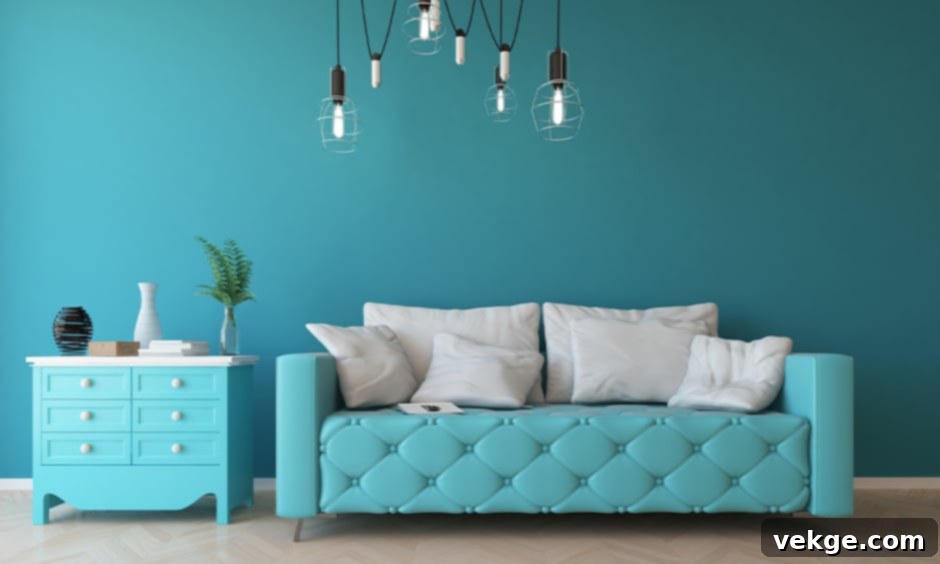
Blue stands as a universally beloved choice for spaces designed to evoke a sense of calm and soothing peace. Its strong association with the sky and ocean naturally brings to mind vastness, stability, and serenity. Lighter shades of blue, such as sky blue, soft turquoise, Tiffany blue, or a gentle periwinkle, are particularly effective. These tones are known to reduce feelings of anxiety, lower heart rate, and promote a sense of deep relaxation, making them perfect for bedrooms, bathrooms, and meditation spaces.
Beyond its calming attributes, blue also symbolizes bravery, determination, and steadfast stability, offering a unique blend of soothing and inspiring qualities. Its incredible versatility allows it to seamlessly integrate into various decor styles, from coastal to modern minimalist. Paired with crisp whites, warm woods, or soft grays, blue creates an inviting and refreshing ambiance that encourages rest and rejuvenation. Whether you opt for a pale wash on your walls or incorporate deeper navy accents, blue remains a top contender for a truly tranquil home.
2. White: The Essence of Purity and Openness
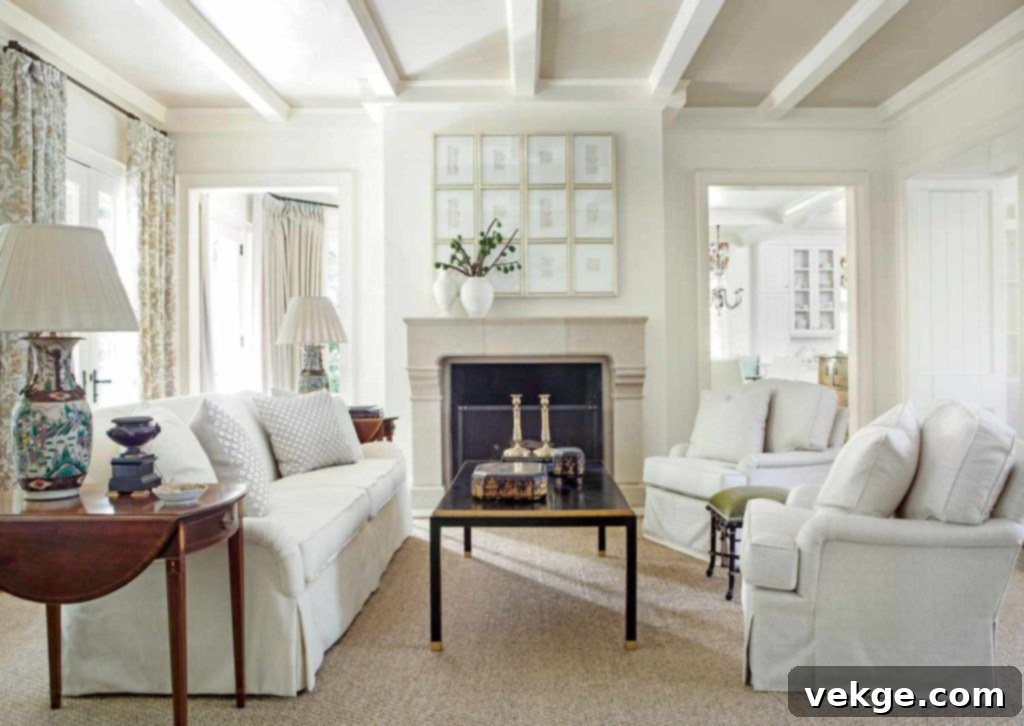
The timeless elegance of white cannot be overstated when aiming to cultivate a calm and pristine interior. White walls instantly create a sense of cleanliness, spaciousness, and airiness, making rooms feel larger and brighter. It serves as a blank canvas, allowing other elements of your decor to shine without competition. While the idea of an all-white setup might evoke images of sterile environments, the key lies in understanding the nuances of white.
There’s a vast spectrum of whites, ranging from cool whites with blue undertones to warm whites with hints of yellow or pink, and even creamy off-whites that add softness. Choosing the right shade for your lighting conditions is crucial. To prevent a stark or dull appearance, integrate varying textures through fabrics, natural wood, and subtle accent colors. Maintaining cleanliness is indeed a factor, but with modern, washable paints and thoughtful material choices, white remains an incredibly powerful color for fostering peace, clarity, and an uncluttered mind. It’s the ultimate choice for a fresh, serene aesthetic.
3. Green: Nature’s Embrace for Inner Peace
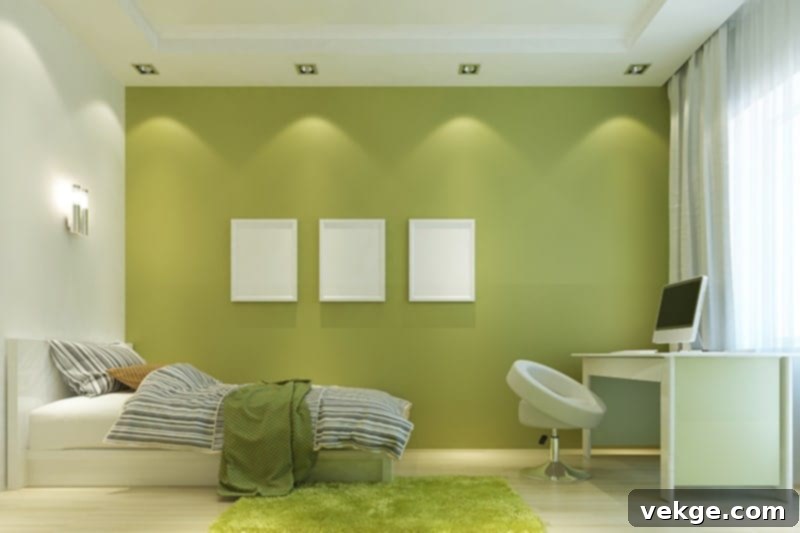
Bringing the outdoors in is a well-known strategy for enhancing well-being, and few colors achieve this as effectively as green. Painting room walls with light shades of green, such as sage, mint, moss, or even a subtle yellowish-green, instantly evokes the refreshing sight of nature. This connection to the natural world provides a profound psychological sense of harmony, balance, and renewal. Green is widely associated with growth, health, and tranquility, making it an excellent choice for any room where relaxation is desired.
Homeowners have increasingly embraced green in recent times, drawn to its organic appeal and stress-reducing properties. It can range from soothing, muted tones that create a spa-like atmosphere to richer, earthy greens that provide a grounding feel. Paired with natural materials like wood, rattan, and an abundance of houseplants, green fosters a deeply calming environment that feels both vibrant and restful. It’s an ideal choice for living rooms, bedrooms, and even home offices, promoting concentration alongside calm.
4. Yellow: A Gentle Ray of Optimism
While often associated with high energy and vibrancy, softer, muted shades of yellow can be incredibly effective in creating a calming and optimistic atmosphere. In many cultures, yellow is a symbol of courage and happiness. Psychologically, it reflects light beautifully, stimulates the left side of the brain, and can enhance logical thinking. For a calming effect, gravitate towards pale lemon, butter yellow, or creamy tones rather than electric or saturated yellows.
These gentle yellows radiate warmth, joy, hope, and a subtle energy that uplifts without overstimulation. They are particularly suitable for rooms that receive ample natural light, where they can truly glow, or for north-facing rooms that need a boost of sunshiny warmth. Yellow can brighten spirits, promote cheerfulness, and create an inviting space perfect for kitchens, dining areas, or even children’s rooms. When chosen carefully, yellow is indeed one of the best choices for cultivating a subtly calming and wonderfully welcoming setup in your home.
5. Violet and Lavender: Regal Serenity
Given that violet naturally possesses blue undertones, it’s no surprise that it also holds a significant calming effect. Specifically, gentle violet or lavender tones are celebrated for their ability to foster calm, inner serenity, and even spiritual introspection. These lighter shades of purple blend the stability of blue with the energy of red, resulting in a sophisticated and tranquil hue. To maximize the calming impact, select violet shades that are soft, muted, and devoid of excessive black, which can make them feel heavy.
Lavender, in particular, is synonymous with relaxation and often linked to aromatherapy and a sense of luxury. It can transform a bedroom into a peaceful retreat or a bathroom into a spa-like sanctuary. The soothing clarity visible in the image above beautifully demonstrates how violet can infuse your room with freshness and a serene elegance. Paired with crisp whites, soft greys, or metallic accents like silver, violet and lavender create an atmosphere that feels both regal and incredibly soothing, perfect for unwinding after a long day.
6. Pink: Gentle Comfort and Nurturing Warmth

While stronger, more vibrant pinks can exude a lively and energetic feeling, the lighter shades of pink offer a distinctly different and profoundly calming effect. Soft pinks, such as blush, rose, or dusty pink, evoke a gentle, carefree sensation akin to the first light of dawn. These tender hues are associated with compassion, nurturing, and comfort, creating an incredibly inviting and reassuring environment. They possess a subtle warmth that can make a room feel cozy and secure without being overly stimulating.
To ensure a truly calming impact, opt for pink paints that are lighter, less saturated, and have minimal red undertones. This prevents an overly exciting or saccharine effect. Soft pinks work beautifully in bedrooms, nurseries, or powder rooms, where a sense of intimacy and softness is desired. They pair wonderfully with neutral colors like grey and white, as well as with metallic accents like brass or warm woods, creating a sophisticated yet serene space that feels both modern and inherently comforting.
7. Grey: Sophisticated Serenity
Grey remains a hugely popular choice in interior design, primarily because of its exceptional ability to create a classy, tranquil, and effortlessly sophisticated atmosphere in any home. Its versatility is unmatched, serving as a perfect neutral backdrop that allows other elements to stand out. Grey can be utilized in virtually any space – from modern living rooms and cozy bedrooms to sleek kitchens and elegant bathrooms – consistently delivering a clean and refined impression.
The calming effect of grey stems from its neutrality and stability. Different undertones, from warm greiges (grey-beige) to cool blues or greens, can subtly alter its character. In a bedroom or living area, embracing the magnificence of grey establishes a foundational sense of calm. You can then strategically introduce pops of brighter, yet still soft, colors through throw cushions, artwork, or linens – imagine lavender, rose, or a mild, sunny yellow – to add warmth and personality without disrupting the overall tranquility. Grey is the cornerstone of a balanced and serene decor scheme.
8. Lavenders: Elegant and Dreamy Calm
Lavender, a soft and gentle shade of purple, is frequently associated with royalty and luxury, yet its true strength lies in its profound ability to maintain an incredibly calm and serene atmosphere. This color holds a unique charm, often linked to aromatherapy and a sense of dreaminess and escape. It’s simply perfect for fostering a quiet and reflective mood within any space. Lavender blends the stability of blue with the subtle energy of red, creating a harmonious and soothing balance.
However, it’s important to acknowledge that lavender, like any strong color, might not appeal to everyone’s personal taste. A potential buyer viewing a property painted entirely in lavender might not be immediately drawn to it. Therefore, consider its application carefully, perhaps using it in more private spaces like bedrooms, meditation corners, or as an accent. When chosen in a soft, muted tone, lavender can create an ethereal and peaceful sanctuary, inviting relaxation and promoting a sense of inner calm.
9. Black: The Sophisticated Cocoon
While not traditionally listed among “calming colors” in the same vein as pastels or light blues, black, when used intentionally and thoughtfully, can create an incredibly calming and sophisticated environment. Often associated with depth, strength, and elegance, black can transform a room into a cozy, enveloping cocoon. A matte black accent wall, for instance, can minimize visual clutter and absorb light, fostering a sense of intimacy and profound quietness. This can be particularly grounding and reduce overstimulation.
For black to be calming, it should be balanced with ample natural light, soft textures, and perhaps contrasting lighter elements. It can make other colors and textures pop, adding a layer of complexity and drama while still maintaining a sophisticated tranquility. Exploring black wall paint ideas reveals how this bold color can be harnessed to create a modern, luxurious, and uniquely peaceful sanctuary, defying conventional perceptions of calm.
Beyond Paint: Integrating Calming Colors Through Decor
While wall paint plays a significant role in establishing the overall color palette, creating a truly calming environment involves more than just the color on your walls. The careful integration of calming colors through various decor elements is equally vital for a holistic approach to serenity.
- Textiles: Think about soft furnishings like curtains, throw blankets, pillows, and rugs. Choosing these items in complementary calming shades (e.g., a soft grey rug in a blue room, or blush pillows on a white sofa) can add layers of comfort and visual interest without overwhelming the senses. Natural fabrics like linen, cotton, and wool enhance the tactile experience, contributing to a cozy and peaceful atmosphere.
- Furniture: Select furniture pieces that harmonize with your calming color scheme. Light wood tones, white upholstery, or pieces in muted fabric colors can seamlessly blend into a serene design. Avoid overly busy patterns or stark contrasts that might disrupt the tranquil vibe.
- Artwork and Accessories: Art offers an excellent opportunity to introduce calming colors and imagery. Landscapes, abstract pieces in soft hues, or botanical prints can reinforce the theme of peace. Decorative accessories like vases, candles, and ceramics in your chosen palette can add subtle touches of color and texture, making the space feel curated and cohesive.
- Natural Elements: Incorporating natural elements such as indoor plants, fresh flowers, and organic materials like stone and unpolished wood further enhances the calming effect. These elements not only add natural colors and textures but also bring life and a sense of connection to the outside world, promoting relaxation.
- Lighting: The quality of light significantly impacts how colors are perceived. Warm, dimmable lighting can enhance the coziness of a room painted in calming colors, especially in the evenings. Using different light sources – ambient, task, and accent lighting – can create depth and highlight serene features, contributing to the overall mood.
By considering these elements alongside your paint choices, you can weave a rich tapestry of calming colors and textures, transforming your home into a truly restorative haven.
Final Words
Ultimately, the perception and effect of colors are deeply personal. What one person finds incredibly calming, another might experience differently. For example, while blue is a universal symbol of peace for many, the crisp cleanliness of white might be the ultimate soothing option for someone else. Each color, from the sophisticated elegance of lavender to the optimistic warmth of a gentle yellow, holds its own unique importance and potential to transform a space.
As you embark on the journey of selecting the perfect colors for your interior, it’s crucial to consider not only the visual appeal but also the profound emotional and psychological impact each hue can have. Your home is your sanctuary, and the colors you choose play a significant role in shaping its energy and your daily experience within it.
By carefully selecting and integrating calming and soothing options, you possess the power to transform your living space into a true haven of relaxation and peace. This conscious choice underscores the immense importance and transformative power that colors bring to our lives and environments. In the end, your thoughtful consideration of all factors – from light and existing decor to your deepest personal preferences – is what truly matters in crafting a space that feels uniquely and perfectly yours. We hope this guide has been a helpful companion on your journey to a more serene home. Feel free to comment and share your views with us!
